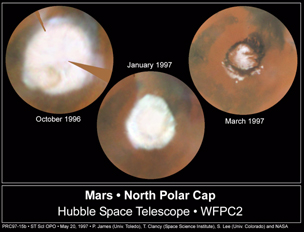









  


|
Carbon Dioxide: The Air of Mars

The composition of Mars' atmosphere
results in a very unfamiliar seasonal effect. Carbon Dioxide, which makes
up 99% of the air on Mars, turns to solid, or "dry ice", when it freezes
at 148 degrees Kelvin (-193 F). When these temperatures are reached in
the atmosphere or on the surface during winter, the atmosphere itself begins
to freeze onto the ground. Each winter, a seasonal polar cap of carbon
dioxide is deposited at the pole (see the figure below). In addition,
a permanent polar cap of
carbon dioxide exists at the south pole, its surface temperature never
exceeding 148 Kelvin. If long-term climate change occurs on Mars, this
deposit would grow or diminish, adding or removing some volume of Mars'
atmosphere. An even larger deposit of carbon dioxide may be stored in Mars'
porous soil, or regolith, by a chemical bonding process called
adsorption.
MVACS will measure the amounts of carbon dioxide in the atmosphere, adsorbed
in the subsurface, and trapped in carbon dioxide-bearing minerals.

|

